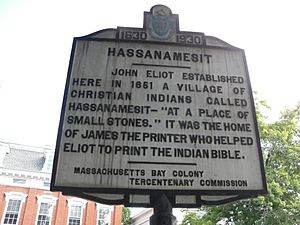James Printer facts for kids
James Printer, also known as Wowaus, lived from 1640 to 1709. He was a Native American from the Nipmuc tribe. James Printer worked as a printer in Cambridge, Massachusetts. He was one of the most famous early Nipmuc writers. He was the first Native American to work as a printer's devil (an apprentice printer) in America. He was also one of John Eliot's best interpreters. James Printer helped create the Eliot Indian Bible, which was a Bible translated into a Native American language.
Contents
Early Life of James Printer
We don't know much about James Printer's early years. He was born in a special Native American town called Hassanamesit. This town was a "Praying Town," which meant its residents had converted to Christianity. Hassanamesit was near what is now Grafton, Massachusetts. James Printer's father was Naoas. Naoas was a Christian convert and an important member of the Christian Native church in Hassanamesit.
Education and Training
James Printer started attending Harvard's Indian College in 1659. While there, he became an apprentice to Samuel Green. Green owned a printing press. Through this training, James Printer became very skilled at setting type for printing. He worked as a printer for most of his life. He lived and worked among the English people for nearly his whole life.
Printing Career
James Printer was the first Native American to work as a printer's devil in America. This means he was an apprentice who helped with printing. He played a very important part in printing John Eliot's Indian Bible. This was the first Bible ever printed in America, and it was written in the Massachusett language.
- James Printer helped finish one thousand copies of the Indian Bible by the end of 1663.
- Other Native Americans also helped Eliot with his Bible. But James Printer is known as Eliot's most skilled interpreter. He did more than anyone else to translate the Bible into the Massachusett language.
- Many experts believe that Native Americans actually wrote most of the Bible. They think James Printer, along with Cockenoe and Job Nesuton, deserve a lot of credit for Eliot's books in Native American languages.
Besides the Indian Bible, James Printer also helped make Indian Primers (basic school books) and two books of Psalms (religious songs). He also set type for books about Puritan missionaries. These books showed how religious he and other Christian Native Americans were. He also helped print the Cambridge versions of Mary Rowlandson's famous story, A Narrative of the Captivity and Restoration of Mrs. Mary Rowlandson. In this story, James Printer appears as a small character during the talks to free Rowlandson.
James Printer worked as a typesetter for sixteen years before a big conflict called King Philip's War began.
Role in King Philip's War
James Printer made a very important contribution to American writing during King Philip's War. He worked as a scribe (a writer) for King Philip, who was also known as Metacomet.
During the war, James Printer left Cambridge and went back to Hassanamesit. When King Philip's War started, James Printer was wrongly accused of being part of the Lancaster raid. This was an attack on Lancaster, Massachusetts. He barely escaped being killed by an angry English crowd who accused him. After he escaped, Metacomet's men attacked Hassanamesit. They gave the people there a choice: either come with them or stay and have their food supplies burned. James Printer and the other people chose to go with Metacomet's men.
- During this time, it is believed that James Printer and other Christian Native Americans who were captured started to feel sympathy for Metacomet's men.
- During the war, the English knew James Printer and disliked him because they saw him as a traitor.
James Printer is known for two important letters he wrote during King Philip's War. These letters were written from the Native Americans to the English.
- The first letter was found stuck to a bridge post outside Medfield, Massachusetts, in 1675. No one signed the note, but many experts believe James Printer wrote it. The note said that the English had caused the war. It also said that Native Americans had nothing to lose but their lives in the fight. But the English might lose their homes and things. This letter was clever because it showed that losing property would make the colonists weak.
- The fact that the message was written in English also showed that only a Native American with a good Christian education could have written it. This proved that the English attempts to make Native Americans act like them were not completely successful.
The second letter is definitely known to have been written by James Printer during King Philip's War. This letter was about getting Mary Rowlandson, Mrs. John Kettell, and other colonists released from being held by King Philip's men. This letter was part of the talks to free Rowlandson and the others. This letter can be seen as James Printer trying to make peace with the English. It is a great example of early Native American writing and shows how skilled James Printer was at writing. It's interesting that he later worked as the typesetter for Mary Rowlandson's own story of her captivity, The Sovereignty and Goodness of God, which was published in 1682.
After the war, James Printer was forgiven. But like other Christian Native Americans, he had to show he was loyal to the colonists.
Later Life
After King Philip's War, James Printer went back to working as a printer in Cambridge. Later, he returned to Hassanamesit and taught there. In 1698, he was described as teaching five Native American families. After the war, James Printer spoke up for the Nipmuck tribe's land rights. His son, Ami, signed the paper in 1727 that sold the last of the tribal lands at Hassanamesit.


